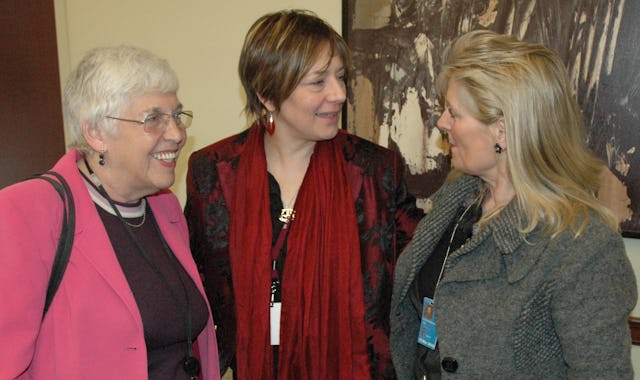Media portrayal of women is focus of panel
NEW YORK, United States — When Jan Floyd-Douglass decided to buy a new car, she bypassed suitable models from eight different manufacturers – and then wrote to tell them why.
"I love your car but I didn't buy it because I don't like your advertisements because they demean women," wrote Ms. Floyd-Douglass, who is on the board of the Women's National Commission in the United Kingdom.
She told the story during a panel discussion titled "Portrayal or Betrayal: How the Media Depicts Women and Girls" held at the UN offices of the Baha'i International Community. The event was planned in conjunction with the annual session of the United Nations Commission on the Status of Women which began on 1 March.
Along with the other panelists, she noted that sexualized images of women in advertising are so commonplace as to seem innocuous.
"My message is, if we don't actually do anything about this, we are complicit in it," said Ms. Floyd-Douglass.
Also on the panel was Sarah Kasule, director of the Mother's Union for Uganda, who said that the way women are portrayed in the African media can be equally negative.
"They are depicted as symbols of sex. Or as something to do with making men comfortable, or giving care," she said.
This trend in the media is a result of both individual choices and institutional forces, added Dr. Michael Karlberg, who is an associate professor in the department of communications at Western Washington University.
"On one hand," he said, "people everywhere are choosing to consume media that feeds base appetites that we have inherited from our animal nature. On the other hand, media institutions have been constructed in ways that purposefully stimulate, reinforce, and exploit these base appetites."
The result is a "feedback cycle" that has created a media environment that is "unjust, unhealthy, and unsustainable," observed Dr. Karlberg.
He said any effort to address the problem must consider the structure of media institutions.
"The assumption is that the media is just another commodity. But the media is not just another commodity. It is a process that facilitates democratic deliberations. It is a process that creates culture."
Part of the problem, he said, is that the media's real product is not content but the delivery of an audience to advertisers. The result is that the media strives to manufacture audiences in the cheapest way possible, through a "high-sex, high-violence, high-conflict content. It doesn't take talent or research or investigative journalism. Yet it stimulates the appetites, much the same way that a high-salt, high-sugar, and high-fat junk food diet does."
The discussion, held on 3 March, was moderated by Baroness Joyce Gould, chair of the UK Women's National Commission.
She said recent studies show that images demeaning to women are increasingly used in the mass media and have an unhealthy impact on the psychological development of both girls and boys.
"For girls, it is about being told they need to be more attractive to men. And for boys, it is about looking upon girls as sexual objects," said Baroness Gould.
Dr. Karlberg spoke of efforts the Baha'i community is making to try to counter the ill effects of exposure to such images in the media by offering moral education for children and young people.
"Baha'is, like people everywhere, are struggling to raise and educate children," he said. "They are trying to do this in a way that cultivates their inherent nobility, that releases their spiritual potential, and that helps them recognize the deep sources of purpose, meaning, and happiness in life.
"It is clear that such spiritual education can be a very important factor in making children less susceptible to messages in their media environment. It is also a very important factor in making children more likely to make thoughtful choices about media consumption as they grow older."
Some counter trends in Uganda may be helpful, said Ms. Kasule, who described how literacy and education levels of women and girls are rising in that country.
"There are many programs for girls to read and write. This is important because they will be able to access information, to access media reports, and then they can respond.
"So I believe things are changing for the better," she said.

